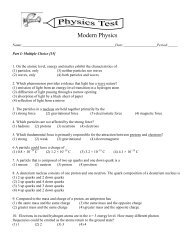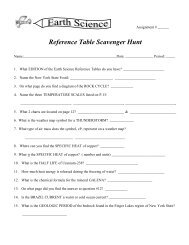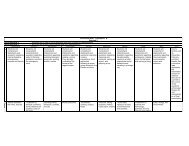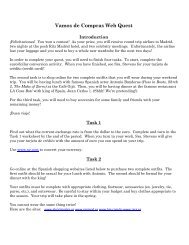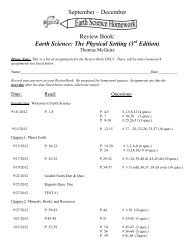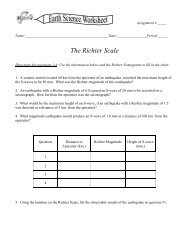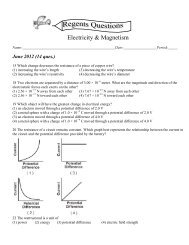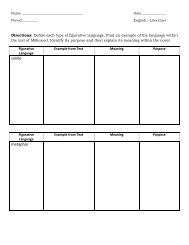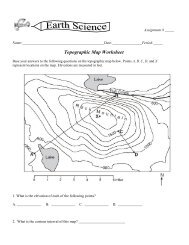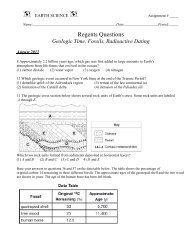Momentum
Momentum
Momentum
You also want an ePaper? Increase the reach of your titles
YUMPU automatically turns print PDFs into web optimized ePapers that Google loves.
<strong>Momentum</strong>Directions:This test is worth 25 credits, but you will notice there are more than 25 points available. You must choose15 out of 20 multiple choice questions from Part I and 5 out of 6 problems from Part II. There is also oneoptional bonus question.You will be allowed to take the entire test home. However there is a catch… You will not be allowed tosimply copy your answers onto the answer sheet. You must study your answers prior to the day of the testand be able to re-write your solutions without the benefit of your notes.I will supply you with a clean copy of all of the questions on the day of the test, BUT the questions may notbe in the same order as your take home copy.On test day, you will be allowed the entire period to complete the test.
<strong>Momentum</strong>Test # _____Name:_________________________________________________Date:________________Period:______Part I Multiple Choice Choose 15 Questions :1. The direction of an object's momentum is always the same as the direction of the object's(1) inertia (2) potential energy (3) velocity (4) weight2. Which quantity has both a magnitude and a direction?(1) energy (2) impulse (3) power (4) work3. A 5.00-kilogram block slides along a horizontal, frictionless surface at 10.0 meters per second for4.00 seconds. The magnitude of the block’s momentum is(1) 200. kg•m/s (2) 50.0 kg•m/s (3) 20.0 kg•m/s (4) 12.5 kg•m/s4. When a 1.0-kilogram cart moving with a speed of 0.50 meter per second on a horizontal surface collideswith a second 1.0-kilogram cart initially at rest, the carts lock together. What is the speed of the combinedcarts after the collision? [Neglect friction.](1) 1.0 m/s (2) 0.50 m/s (3) 0.25 m/s (4) 0 m/s5. A 75-kilogram hockey player is skating across the ice at a speed of 6.0 meters per second. What isthe magnitude of the average force required to stop the player in 0.65 second?(1) 120 N (2) 290 N (3) 690 N (4) 920 N6. A 0.149-kilogram baseball, initially moving at 15 meters per second, is brought to rest in 0.040 second bya baseball glove on a catcher’s hand. The magnitude of the average force exerted on the ball by the glove is(1) 2.2 N (2) 2.9 N (3) 17 N (4) 56 N7. A motorcycle being driven on a dirt path hits a rock. Its 60.-kilogram cyclist is projected over thehandlebars at 20. meters per second into a haystack. If the cyclist is brought to rest in 0.50 second, themagnitude of the average force exerted on the cyclist by the haystack is(1) 6.0 × 10 1 N (2) 5.9 × 10 2 N (3) 1.2 × 10 3 N (4) 2.4 × 10 3 N8. A 3.1-kilogram gun initially at rest is free to move. When a 0.015-kilogram bullet leaves the gun with aspeed of 500. meters per second, what is the speed of the gun?(1) 0.0 m/s (2) 2.4 m/s (3) 7.5 m/s (4) 500. m/s9. Cart A has a mass of 2 kilograms and a speed of 3 meters per second. Cart B has a mass of 3 kilogramsand a speed of 2 meters per second. Compared to the inertia and magnitude of momentum of cart A, cart Bhas(1) the same inertia and a smaller magnitude of momentum(2) the same inertia and the same magnitude of momentum(3) greater inertia and a smaller magnitude of momentum(4) greater inertia and the same magnitude of momentum
10. A 0.45-kilogram football traveling at a speed of 22 meters per second is caught by an 84-kilogramstationary receiver. If the football comes to rest in the receiver’s arms, the magnitude of the impulse impartedto the receiver by the ball is(1) 1800 N s (2) 9.9 N s (3) 4.4 N s (4) 3.8 N s___________________________________________________________________________________11. An object traveling at 4.0 meters per second has a momentum of 16 kilogram. meters per second. Whatis the mass of the object?(1) 64kg (2) 20kg (3) 12kg (4) 4.0 kg12. What is the magnitude of the velocity of a 25-kilogram mass that is moving with a momentum of 100.kilogram. meters per second?(1) 0.25 m/s (2) 2500 m/s (3) 40. m/s (4) 4.0 m/s13. A constant unbalanced force acts on an object for 3.0 seconds, producing an impulse of 6.0 newton.seconds. What is the magnitude of the force?(1) 6.0 N (2) 2.0 N (3) 3.0 N (4) 18 N14. A 6.0-kilogram block, sliding to the east across a horizontal, frictionless surface with a momentum of 30.kilogram•meters per second, strikes an obstacle. The obstacle exerts an impulse of 10. newton•seconds to thewest on the block. The speed of the block after the collision is(1) 1.7 m/s (2) 3.3 m/s (3) 5.0 m/s (4) 20. m/s15. A 1.0-kilogram laboratory cart moving with a velocity of 0.50 meter per second due east collides withand sticks to a similar cart initially at rest. After the collision, the two carts move off together with a velocityof 0.25 meter per second due east. The total momentum of this frictionless system is(1) zero before the collision (3) the same before and after the collision(2) zero after the collision (4) greater before the collision than after the collision16. A bicycle and its rider have a combined mass of 80. kilograms and a speed of 6.0 meters per second.What is the magnitude of the average force needed to bring the bicycle and its rider to a stop in 4.0 seconds?(1) 1.2 x10 2 N (2) 3.2 x10 2 N (3) 4.8 x10 2 N (4) 1.9 x10 3 NBase your answers to questions 17 through 20 on the diagram below which represents carts A and B beingpushed apart by a spring that exerts an average force of 50. newtons for a period of 0.20 second. [Assumefrictionless conditions.]35. What is the magnitude of the impulse applied by the spring on cart A ?(1) 5.0 N-s (2) 10. N-s (3) 50. N-s (4) 100 N-s17. Compared to the magnitude of the impulse acting on cart A, the magnitude of the impulse acting oncart B is(1) one-half as great (2) twice as great (3) the same (4) 4 times as great18. Compared to the velocity of cart B at the end of the 0.20-second inter- action, the velocity of cart A is(1) one-half as great (2) twice as great (3) the same (4) 4 times as great19. Compared to the total momentum of the carts before the spring is released, the total momentum of thecarts after the spring is released is(1) one-half as great (2) twice as great (3) the same (4) 4 times as great20. What is the average acceleration of cart B during the 0.20-second interaction ?(1) 0 m/s 2 (2) 10. m/s 2 (3) 25 m/s 2 (4) 50. m/s 2
Bonus Question:21. The diagram below represents two masses before and after they collide. Before the collision, mass m A ismoving to the right with speed v, and mass m B is at rest. Upon collision, the two masses stick together.Which expression represents the speed, v', of the masses after the collision? [Assume no outside forces areacting on m A or m B .]
<strong>Momentum</strong>: Part II ProblemsName:_________________________________Date:____________Period:____Directions: Solve 5 of these problems prior to the test. Study the results and be able to repeat the solutionson the day of the test. You will NOT be allowed to simply copy your answers. You will have to rememberhow you solved the problems, and reproduce those solutions on the test.22. Calculate the time required for a 6000.N force to stop a 1200.kg car initially traveling at 10. meters persecond. [Show all work, including the equation and substitution withunits.] [2]______________________________________________________________________________________23. Calculate the magnitude of the impulse applied to a 0.75-kilogram cart to change its velocity from 0.50meter per second east to 2.00 meters per second east. [Show all work, including the equation and substitutionwith units.] [2]_______________________________________________________________________________________Base your answers to questions 24 and 25 on the information below:The instant before a batter hits a 0.14-kilogram baseball, the velocity of the ball is 45 meters per secondwest. The instant after the batter hits the ball, the ball’s velocity is 35 meters per second east. The bat andball are in contact for 1.0 x10 –2 second.24. Determine the magnitude and direction of the average acceleration of the baseball while it is in contactwith the bat. [Show all work, including the equation and substitution with units.] [2]25. Calculate the magnitude of the average force the bat exerts on the ball while they are in contact. [Showall work, including the equation and substitution with units.] [2]______________________________________________________________________________________Base your answers to questions 26 and 27 on the information below:A 1200-kilogram car moving at 12 meters per second collides with a 2300-kilogram car that is waiting atrest at a traffic light. After the collision, the cars lock together and slide. Eventually, the combined cars arebrought to rest by a force of kinetic friction as the rubber tires slide across the dry, level, asphalt roadsurface.26. Calculate the speed of the locked-together cars immediately after the collision. [Show all work, includingthe equation and substitution with units.] [2]27. Calculate the magnitude of the frictional force that brings the locked-together cars to rest. [Show allwork, including the equation and substitution with units.] [2]




